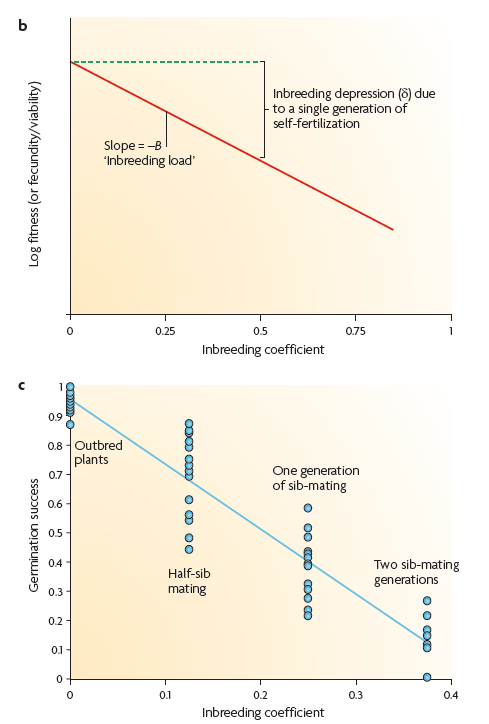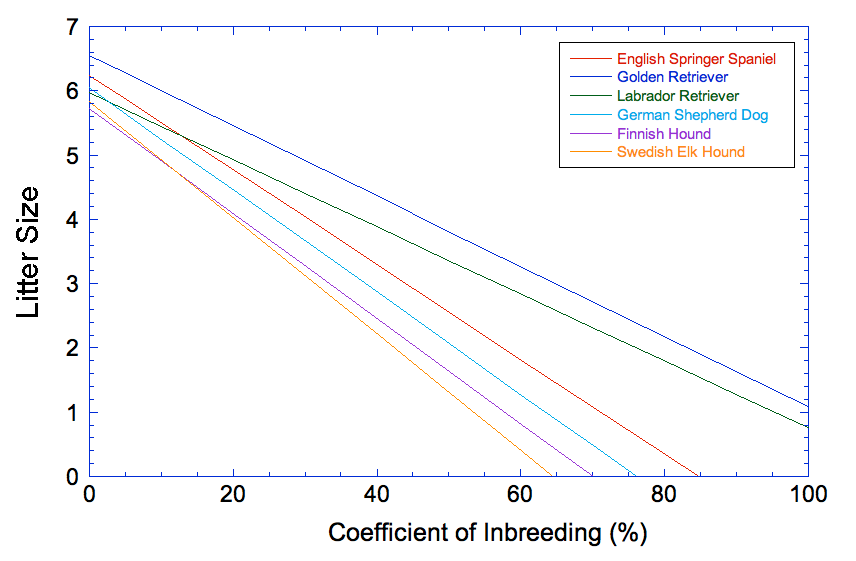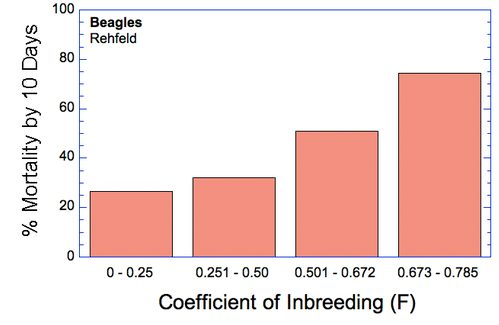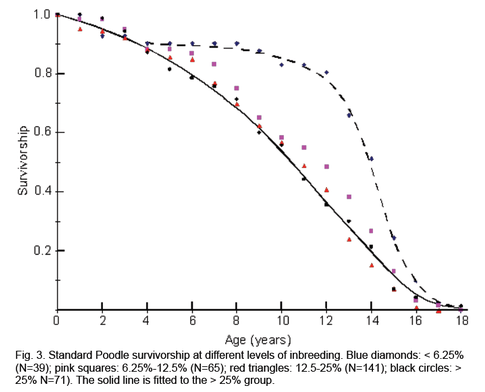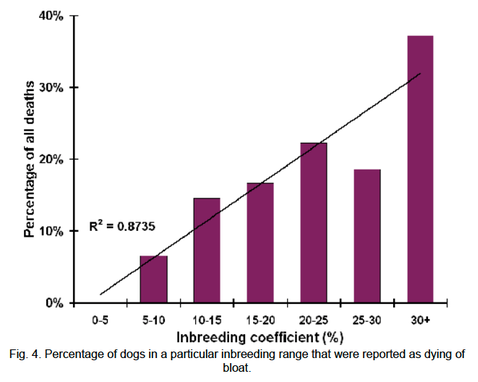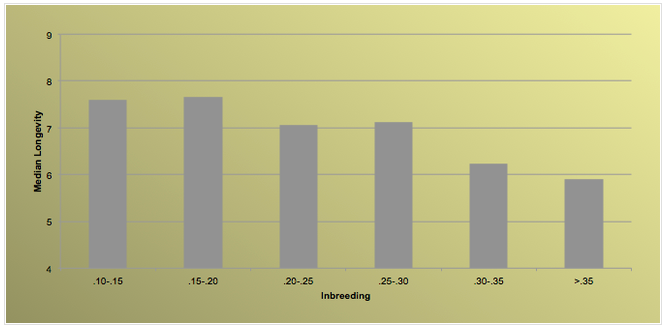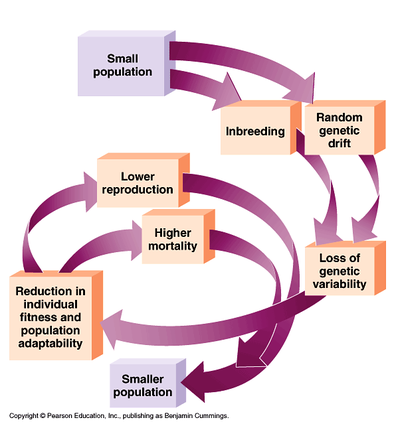It's easy to make the lists:
| ADVANTAGES
| DISADVANTAGES
|
Why does inbreeding increase uniformity and prepotency?
Inbreeding increases homozygosity. By that, we mean that if there are two (or more) alleles in the population for a gene, the frequency of AA and aa will increase, and Aa and aA will decrease. If a dog is homozygous for AA, then it can ONLY pass the A allele on to its offspring - it is "fixed" for the A gene. The greater the degree of homozygosity of an animal's genome, the more uniform its offspring will be because they will all get the same allele for many genes from that parent. If you are trying to breed for specific traits, this is a huge advantage. Variation among litter mates will be reduced, and the inbred parent will be said to be "prepotent" - it creates offspring with a recognizable "look".
This would all be good except that nature doesn't especially like homozygosity. In hundreds of studies, in many different species both plant and animal (including domestic animals), there is irrefutable evidence that homozygosity comes with a price. Wright noted that
"...it may be readily shown that the decrease in vigor in starting inbreeding in a previously random-bred stock should be directly proportional to the increase in the percentage of homozygosity", and "As for the other effects of inbreeding, fixation of characters and increased prepotency, these are of course in direct proportion to the percentage of homozygosis."
This is illustrated in these figures. "Fitness" is a measure of an animal's ability to produce offspring that can contribute genetically to the next generation. Producing offspring that don't themselves produce offspring gives you a fitness of zero. It might be that the offspring are infertile, or died after birth, or were too slow or too stupid to outrun a predator - doesn't matter, the measure of interest is whether an animal's genes will stay in the gene pool through the next generation.
Inbreeding reduces fitness (the red line), and the decrement in fitness is proportional to the degree of inbreeding. This reduced fitness is called "inbreeding depression", which is a catch-all for all things that play a role in reducing fitness. If you start with an outbred plant (so high heterozygosity) that self-pollinates (self-fertilization, so we don't have to worry about the genetics of the mate), germination of the seeds produced will be reduced. As you continue to self-pollinate successive generations, the reduction in germination is proportional to the inbreeding coefficient and therefore the amount of homozygosity (blue line).
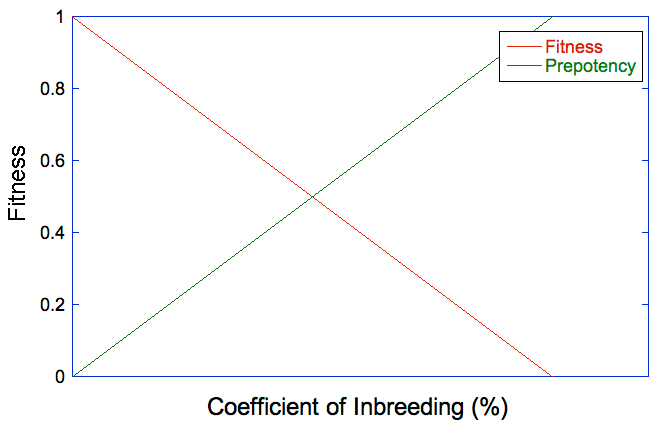
This is a very handy relationship. The cost and benefit of inbreeding are directly proportional to the COI. This means that a breeder can choose a level of inbreeding that is a good balance between cost and benefit.
Inbreeding depression in dogs
Are there data that show a negative effect of inbreeding depression in dogs?
Here are some data on litter size of 6 breeds of dogs from the records of the Swedish Kennel Club (Effects of inbreeding on dog fertility). The first thing I would warn about is that these are probably 10 generation COIs, which we already know are likely to underestimate the true COI especially for breeds that have been around for a while (e.g., Goldens and Labradors). So understand that the placement of these lines relative to each other and the X axis is not likely to be the "truth".
For our purposes, however, it doesn't really matter. What we want to see is the effect of COI on litter size, and as observed by Wright and many others, the reduction in litter size as inbreeding increases is linear.
The slopes of these lines tell us exactly what this "cost-benefit" ratio is. For these breeds, those slopes are about 0.1, which means that an increase in inbreeding of 10% reduces litter size by about 1. If normal litter size is about 6, a COI of 30% - which is not uncommon in many breeds - would reduce the litter size by HALF. That is half as many offspring from which to choose your "pick", and on top of this realize that these puppies will have reduced fitness in the ways noted by Wright - they are likely to be smaller, less vigorous, have more birth defects and higher mortality, grow more slowing, have shorter lifespan, and of course increased incidence of genetic disorders caused by recessive mutations.
How is inbreeding depression manifested in offspring? The impact on puppy mortality is clear. These data for Beagles unfortunately pool together all the dogs with COI less than 25% (so we can't see whatever effect there , but the average mortality by 10 days for this group was greater than 20%. As inbreeding increases above 25%, the mortality increases, to about 30% for dogs with COI between 25-50%, and higher still as COI increases.
In Standard Poodles, dogs with inbreeding less than 6% live 4 years longer than those with higher COI, and the risk of bloat is roughly proportional to the increase in COI - a 10% increase in COI elevates the risk of bloat by about the same amount.
In Bernese Mountain Dogs, each 10% increase in COI reduces lifespan by 200 days. For a dog with COI of 30%, that's a reduction in lifespan of almost two years.
So how much inbreeding is too much?
Now that's the million dollar question. If inbreeding was only good, animal breeders would be merrily inbreeding and the animals would be thriving. But most animal (and plant) breeders go to some pains to manage inbreeding, and for reasons like the ones above. So how do you evaluate the costs against the benefits?
The rule of thumb for sustainable breeding of both wild and domestic animals is to keep inbreeding below 5%, and to consider 10% an upper limit for a population. There might be occasional animals that are much higher than this (for example, in maintaining multiple herds to use for outcrossing within a line), but when the population average goes higher than about 10% things begin to go downhill. As fertility goes down and litters get smaller, there are fewer animals born each generation, and those that are have an increased risk of genetic disorders, shorter lifespans, and general lack of vigor. This becomes a negative feedback loop that is called "the extinction vortex", and once a population heads down this path it can be very difficult to stop. Note again, that threshold for this vortex phenomenon is about COI = 10%. For most livestock breeds being bred sustainably, inbreeding is kept well below this. Organization breeding guide and service dogs keep inbreeding below 10%. But among purebred dogs otherwise, a COI (calculated back to founders) could be very difficult to find. And evidence of inbreeding depression and the other consequences of inbreeding are very evident - singleton litters, high rates of cancer in young dogs, allergies, and many other issues that seem to be "normal" in the breeding of dogs these days.
Inbreeding can be used to produce exceptional animals, but the cost is very real.
